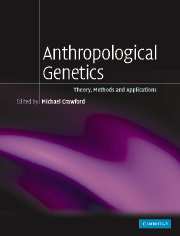Book contents
- Frontmatter
- Contents
- List of Contributors
- Preface
- Chapter 1 Foundations of Anthropological Genetics
- Part 1 Theory
- Part 2 Methods
- Chapter 4 The Importance of Field Research in Anthropological Genetics: Methods, Experiences and Results
- Chapter 5 The Confluence of Anthropological Genetics and Anthropological Demography
- Chapter 6 Molecular Markers in Anthropological Genetic Studies
- Chapter 7 The Use of Quantitative Traits in Anthropological Genetic Studies of Population Structure and History
- Chapter 8 Ancient DNA and its Application to the Reconstruction of Human Evolution and History
- Part 3 General Applications
- Part 4 Part IV The Human Diaspora
- Index
- References
Chapter 4 - The Importance of Field Research in Anthropological Genetics: Methods, Experiences and Results
Published online by Cambridge University Press: 05 June 2012
- Frontmatter
- Contents
- List of Contributors
- Preface
- Chapter 1 Foundations of Anthropological Genetics
- Part 1 Theory
- Part 2 Methods
- Chapter 4 The Importance of Field Research in Anthropological Genetics: Methods, Experiences and Results
- Chapter 5 The Confluence of Anthropological Genetics and Anthropological Demography
- Chapter 6 Molecular Markers in Anthropological Genetic Studies
- Chapter 7 The Use of Quantitative Traits in Anthropological Genetic Studies of Population Structure and History
- Chapter 8 Ancient DNA and its Application to the Reconstruction of Human Evolution and History
- Part 3 General Applications
- Part 4 Part IV The Human Diaspora
- Index
- References
Summary
Introduction
Field research helps us answer some basic, almost universal, questions: ‘Who are we? Where did we come from? ‘How did we get here?’
As discussed in Chapter 1 of this volume, anthropological genetics was formalized as a field of investigation during the 1970s and 1980s, with the twin foci of genetic structure of human populations and genetic-environmental interactions in the dissection of the genetic architecture of complex phenotypes (Crawford, 2000b). What distinguishes anthropological genetics from human genetics is its emphasis on smaller, reproductively isolated, non-Western populations, plus a broader, biocultural perspective on complex disease etiology and transmission. Similarly, the reconstruction of the human diaspora and the phylogeny of our species, based on molecular genetic markers, required comparisons among human populations widely dispersed geographically. As a result of these foci, field research became an integral part of anthropological genetics and provided considerable insight into the understanding of human variation and disease processes.
This chapter summarizes the following aspects of field investigations: (1) The reasons for conducting field research in anthropological genetics. For most of us the air-conditioned laboratory is a much more comfortable place to conduct research than in some hot, tropical jungle, where you become part of the insect's food chain, or the frigid North with cold stress and summer mosquitoes. Why expose yourself to the risks of the hot sun and voracious insects if you can answer basic anthropological genetics questions in the relative comfort of your laboratory? (2) Describes the preparation necessary for developing a field programme.
- Type
- Chapter
- Information
- Anthropological GeneticsTheory, Methods and Applications, pp. 79 - 111Publisher: Cambridge University PressPrint publication year: 2006



